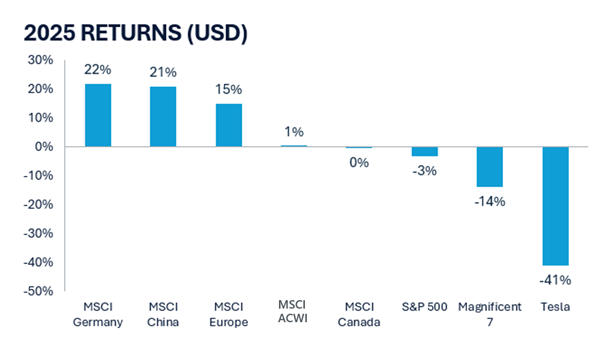2025 was supposed to be a good year - what happened?
Following initial optimism towards President Trump’s America-first, pro-growth agenda, the narrative has quickly changed in recent weeks to one of “US growth scare”.
The S&P 500 has retreated quickly as investors reposition towards areas of better perceived value or opportunity. Few expected China and Europe to outperform the U.S in 2025, let alone Canada (albeit mildly), which has borne the brunt of Trump’s initial tariffs.

Source: Bloomberg Finance L.P. Returns are YTD as of 17/03/2025. Past performance is no guarantee or a reliable indicator of future results.
Headlines quickly highlight the S&P 500 entering “correction territory” (a decline of >10% from highs). Stepping back, investors should also acknowledge this follows a >60% rally since late 2022 and a 5% gain over the first seven weeks of 2025.
All-in-all, the S&P 500 is down a mild 2% year-to-date and global equities (ACWI) are slightly higher.
This recent sell-off is a healthy correction, in our view, acknowledging heightened risks and also follows extraordinary market strength.
Despite expectations for a bumpier ride in 2025, we are optimistic that global equities can still deliver a positive return this year.
2025 was supposed to be a good year - what happened?
Numerous datapoints have signalled weakening sentiment amongst U.S. consumers and corporates, hitting U.S. growth optimism and highlighting the impacts of tariffs and government spending uncertainty.
It appears there is a greater appetite to slow the U.S. economy in the near term, with the view that it will create a stronger economy longer term; namely, via reducing the U.S.’ 6% fiscal deficit.
In our view, this goes against expectations for Trump’s pro-growth agenda and was not something broadly expected by the market.
We believe tariffs, if implemented universally and to the extent proposed during Trump’s campaign, would have been highly destructive to global growth and supply chains. While it appeared, initially, there was a more rational, data-driven approach (“reciprocal tariffs”), the often-random announcements and indecisiveness we have witnessed more recently creates uncertainty and leaves many questioning if there is a well-thought-out, strategic plan in place. The perceived “firing from the hip” on tariffs creates an incredibly difficult backdrop for countries and corporates to plan and rely upon. We think it also risks reigniting inflation.
Efforts to cut government spending (“DOGE”) by as much as USD1 trillion have also been more aggressive than anticipated. U.S. GDP directly relies on government spending, and it seems inevitable that growth will be impacted to some extent.
While we viewed 2024 as a year of the immaculate soft landing, we believe there is a risk of shallow recession in 2025.
While not our base case, a recession would likely be short and mild, in our view, and we are encouraged that since late-2024, the U.S. Federal Reserve (Fed) has already cut rates by 100bps, allowing time for this easing to flow through (with a lag) to a slowing economy.
Overall, we believe these spending cuts are a net positive for the US economy. Short term pain, focused on reducing unsustainable deficit-financed growth, puts the US economy on a more sustainable path.
All of this has taken some of the shine off of “US exceptionalism”. Couple this with China’s DeepSeek unveiling in January and investors are now questioning whether there are better opportunities elsewhere. Whether it’s slower U.S. economic growth or credible artificial intelligence (AI) competition offshore, investors are embracing a wider opportunity set and the market has truly broadened.
An awakening of Europe
Trump is creating uncertainty abroad, whether it be tariffs or his stance on a Russia/Ukraine ceasefire. The U.S. appears to be walking back their international investment/involvement, which requires other nations to fill that void. Countries that have traditionally relied on the U.S. for security are being forced to think about self-reliance.
Germany’s recently announced plans to expand its fiscal deficit clearly highlights the need to expand defence spending and be in control of its own destiny.
This has the potential to create a new investment cycle.
In our view, Germany’s plans to increase defence and infrastructure spending should benefit GDP and create new opportunities. We also think it should also result in higher inflation and interest rates. Up until this point, Germany has not been a broad destination of compelling investment opportunities. The global opportunity set for investors is becoming more interesting.
A bumpier ride for investors: balance, opportunity & optimism
2025 is shaping up to be different. Markets have delivered exceptional returns since late 2022 and from highs, must now navigate slower U.S. growth, Trump uncertainty and a readjustment of global partnership.
We were intentional in our efforts to balance the portfolio in 2024, positioning for resilience to potential shocks.
In this environment, we favour diversifying the portfolio even more broadly across sectors and regions, both due to expectations for a bumpier ride as well as new, emerging opportunities.
We believe this offers greater ballast while not sacrificing alpha potential.
The world is changing, which is an exciting backdrop for active managers. In our view, the narrow success of the Magnificent 7 has reversed this year and markets recently dubbed “uninvestible” (China) are leading global returns.
In this environment we are finding new opportunities. In Europe, the future prospects for infrastructure investment, defence spending and higher interest rates create opportunities in areas such as construction and financials.
We are also on the lookout for oversold opportunities created by accelerating U.S. pessimism, requiring careful discernment, as not all compressing valuations are returning to “cheap” levels.
We also continue to see opportunities to add to emerging markets. Countries such as Indonesia and Philippines, for example, have been dragged down with broader emerging markets on tariff concerns yet are both predominantly domestic economies with no trade surplus with the U.S. More recently, we have also capitalised on India’s market weakness, as we see signs the country will emerge from a cyclical slowdown.
Higher volatility can be expected as the world navigates these challenges, however change creates opportunity and from an existing position of prudence and portfolio balance, we are encouraged that our opportunity set has increased.
Our strategy aims to find opportunities for investors across the whole world and following a period of exceptional U.S. strength, we are optimistic that 2025 can deliver positive returns and believe we are well-positioned to generate alpha in an environment of more globally diverse opportunity.
Gain an edge with our best thinking on investments and markets
Market shifts. Global news. Investment trends. Our experts distill the latest movements in the financial world into actionable insights. Access more insights here.
3 topics

